|
|
Nissan Fuga / Infiniti
M-series / Q70
|
 |
|
|
Debut: 2009
Maker: Nissan
Predecessor:
Fuga Mk1
|
|
|
|
Published
on 16
Apr 2010
|
All rights reserved.
|
|
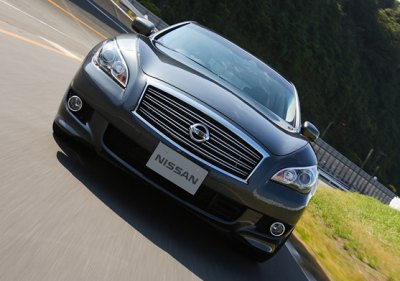 Nissan thinks its executive large car
is also a sport sedan... can the dual-purpose be achieved ?
Nissan thinks its executive large car
is also a sport sedan... can the dual-purpose be achieved ?
Nissan large cars have been
struggling to find an identity for long. Since the slump of the
domestic large car market in the early 1990s, traditional nameplates
like Cedric, Gloria and Leopard gave place to international ones
bearing Infiniti badge. However, the road to build Infiniti as a
premium car brand has never been smooth. It tried two generations of
Q45 without success. Ditto the first generation I-series and G-series.
Entering the new millennium, Nissan decided to concentrate all Infiniti
efforts to the sole rear-drive platform that the company has, or
so-called "FM" platform. No matter the new G-series, M-series (aka
Nissan Fuga) or FX, all were built on the same architecture with common
suspensions and V6 powertrains. This allowed not only better
engineering but also a sporty driving character in the mold of BMW.
Things started improving…
On paper, the second generation Infiniti M-series or Nissan Fuga is not
much different from the outgoing car. Due to the same underpinning
platform, its size and mechanical layout are mostly intact. However, as
in the case of the second generation G-series, Nissan said it fine
polished everything to make a more appealing car overall.
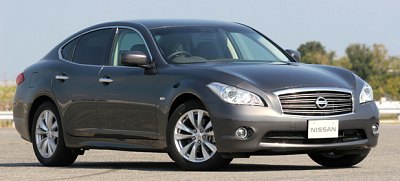 Nissan chose a muscular theme in the
attempt to lure American buyers...
Nissan chose a muscular theme in the
attempt to lure American buyers...
First of all is the new styling, said
to be inspired by the
2009 Detroit concept car Essence, but the fact is actually reversed –
how could a concept car shown in early 2009 inspired a production car
destined to Japanese showrooms in late 2009 ? Normally, styling has to
be frozen 3 years before production in order to leave enough time for
development and type approval. This explain while the new M looks more
flowing, more dynamic and therefore more interesting than the old car,
it is not yet developed to the state of Essence, which is really
striking. There is still some bulkiness in its appearance. Unlike the
avant-garde designs of Jaguar XF, BMW 5-series or Mercedes E-class,
Nissan chose a muscular theme in the attempt to lure American buyers.
Does that work ? I'm not sure, but I do think it will get outdated
quickly like American muscle cars.
The car rides on the same, 2900mm wheelbase as the old car. Its
suspensions consisting of double-wishbones up front and multi-links at
the rear are also essentially the same as before. However, fine tuning
to the suspensions increased lateral stiffness to resist body roll,
while new bushings improved NVH isolation. As before, 4-wheel active
steering is optional. It is a useful device to stabilize high speed
lane changing, but unlike rival systems (such as BMW's), its rear
wheels do not steer in opposite direction at low speed, so it neither
sharpens maneuver in the twisty nor shortens turning circle for
parking. 4WAS works poorest at its threshold between 25 and 30 mph,
where steering feel is mushy. Unfortunately, that is also the speed we
usually encounter on mountain roads. On faster roads, the driving
experience is much more satisfying - the steering is precise and
linear, the chassis is well balanced and braking feels reassuring.
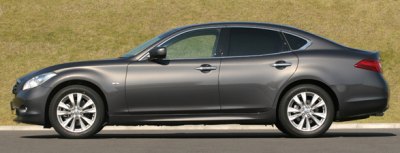 Standard suspension is a better
compromise than sport suspension...
Standard suspension is a better
compromise than sport suspension...
Sadly, the big Nissan does not offer
adaptive suspensions of
any kind, not even mechanical type. This is almost a sin in the large
executive car segment. What it does offers are two different chassis
tunings – a softer standard setup paired with 245/50R18 tires and a
sport setup which comes with stiffer suspensions and aggressive
245/40WR20 rubbers. On the road, the standard setup is probably too
civilized to the liking of keen drivers, while the sport setup results
in harsh and noisy ride that we can hardly find in any other rivals. A
medium setup would have been the best compromise.
The aggressiveness of the sport suspension package and the muscular
exterior design reflect the performance bias Nissan wants to promote
with this car, whether it is a smart judgement. To enhance performance
further, Infinti M56 offers a new 5.6-liter V8 engine. The 5552 c.c.
unit might be derived from Nissan's truck engine, but it has been
upgraded with VVEL variable valve timing and lift system and direct
fuel injection, resulting in a remarkable 420 horsepower and 417 lb-ft
of torque. This not only eclipses the outgoing M45 by a massive 85
horses, but also topples any rivals in the class, e.g. BMW 550i
(408hp), Mercedes E500 (388hp) and Jaguar XF 5.0 (385hp). We expect
0-60 mph to take around 5 seconds. Early road tests found its throttle
mapping was not properly calibrated, so it was difficult to achieve a
smooth launch. However, more fine tuning will sort out this problem.
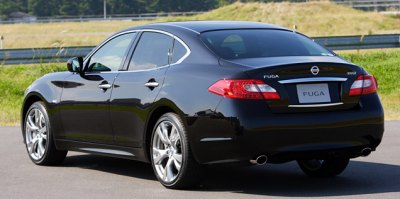 VQ engine is no longer renowned for
smoothness and quietness...
VQ engine is no longer renowned for
smoothness and quietness...
While M56 is the image flagship, its
take rate is not
supposed to exceed 15 percent in the USA. This mean the majority of
sales will go to M37. In Japan, Fuga is offered with V6 engines only -
either a 225hp 2.5-liter VQ25HR or 333hp 3.7-liter VQ37VHR. The latter
is the same as the engine of M37 or G37. It is not short of high-end
power, but its strength does not arrive until 3500 rpm, which means in
everyday driving it does not feel as punchy as BMW 535i or the turbo
diesel motors of most European rivals. The refinement of VQ37VHR is
also in question. In the largest capacity form it is no longer renowned
for smoothness and quietness, displaying more vibration and noise than
you would expect for an executive car motor. In fact, the
Japanese-bounded 2.5 V6 is actually better suited to its purpose.
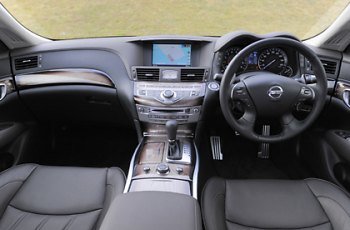 Noise insulation is its weakest
link... despite of active noise control
Noise insulation is its weakest
link... despite of active noise control
As you would expect, the Infiniti M or
Nissan Fuga offers
plenty of interior space. Its seats are plush and comfortable.
Materials are classy, though the interior design is far from tasteful.
Noise insulation is its weakest link, no matter road noise on sport
suspensions or wind noise at motorway speed. You may also get tired of
its engine noise, which is said to be deliberately inducted to the
cabin for your joy. If you wish, active noise control can be activated
to produce an opposite-phase sound to cancel the noise. It works pretty
well in steady state cruise, but if you prod the throttle or make
gearchange, ANC will not be fast enough to react, so it is not a
replacement of a well insulated cabin.
Compare with Mercedes E-class, BMW 5-series and Jaguar XF, Infiniti
M-series or Nissan Fuga is apparently a small scale investment. It
lacks the sophistication and refinement to compete directly with those
rivals, no wonder it opts for a sporty route. After all, an executive
car derived from the platform of 370Z has no other alternatives. |
Verdict:    |
Published
on 16
Feb 2011
|
All rights reserved.
|
|
Fuga Hybrid / Infiniti M35h
|
|
Nissan
claims the
Fuga Hybrid offers the power of V8 yet consumes the same fuel as a
typical
4-cylinder engine. If you do not believe, read the following figures:
Japanese
combined
cycle:
| Lexus GS450h |
40.1 mpg |
| Toyota Crown Hybrid |
44.6 mpg |
| Nissan Fuga Hybrid |
53.6 mpg |
US
EPA consumption
(Highway / City / Combined):
| Lexus GS450h |
22 / 25 / 23 mpg
|
| Infiniti M35h |
32
/ 27 / 29 mpg |
As seen, Nissan's
first own proprietary hybrid technology is far more efficient than
Toyota's
Hybrid Synergy Drive. How can it achieve that ? The answer is a simple
yet
highly efficient transmission system. While Toyota and most other
hybrids employ
planetary CVTs to couple electric motors to the drivetrain, the Nissan
makes do
with the same 7-speed automatic transmission as the regular Fuga.
However, in
place of the power-consuming torque converter is a couple of
computer-controlled
clutches, one engages the engine and another engages electric motor.
The electric
motor is packaged neatly inside the transmission casing, sandwiching
between
the engine and transmission. Supply by a small, 1.4kWh lithium-ion
battery, it
produces a maximum 68 hp and 199 lbft of torque, capable of getting the
Fuga to
100km/h (62mph) without firing the engine. The engine is not the same
one as
the regular Fuga (or Infiniti M37), but a smaller, 3.5-liter VQ35HR
that runs
on more thermal efficient Atkinson combustion cycle – i.e. its
expansion stroke
is made longer than compression stroke. VVEL variable valve lift
mechanism has
been ditched as high rev is the enemy to fuel economy. Still, the
engine
produces a respectable 306 hp. Net power of the whole system is 360 hp.
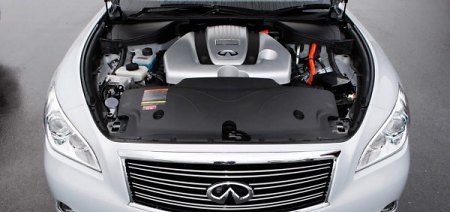
The car runs on
battery alone under light load. When full power is required for
acceleration or
high-speed running, both the engine and electric motor are engaged by
the
clutches to power the car. When the battery is depleted, the engine is
engaged
to provide all the power, while the electric motor is also engaged but
to work
as a generator to recharge the battery. During deceleration, the engine
is
disengaged and the motor is engaged to implement regenerative braking.
On the road, the
driving impression is pretty good. Although the twin-clutch design does
not
shift between power modes as seamless as its CVT counterparts, neither
can it
be described as unrefined. Nissan's engineers have done a good job to
smoothen
the transition with high-speed mechatronics, so you get only a short
moment of
power interruption. Compare to the regular Fuga 3.7, the hybrid
displays much stronger
bottom-end acceleration thanks to that 199 lbft of electric torque. It
is even
comparable to the V8-powered Infiniti M56, although it runs out of
steam more
quickly.
Handling is close
to the regular car. Although it carries 110 kg more than 3.7, most of
those
extra weight (the battery) is put under the boot. Therefore its
front-to-rear
weight distribution is improved from 54:46 to 52:48. Moreover, the
hybrid
employs the same rubbers and suspension setting as the non-Sport
setting
regular car. The only downside is poor feedback from the brake pedal, a
typical
problem to hybrids.
However, like the regular version, the Fuga hybrid still
fails to stand out from its class, no matter in terms of styling,
driving
dynamics or refinement. You will have more fun in a BMW 5-series or
Jaguar XF,
and more comfort in a Mercedes E-class or Audi A6. What it excels is
purely
fuel economy. If that means a lot to you, then you won't have a better
choice. |
Verdict:    |
Published
on 10
Jan 2015
|
All rights reserved.
|
|
Infiniti Q70 and Nissan Cima
|
|
Despite of the new name,
Infiniti Q70 is only a restyled M-series. The new front end, which has
strong family resemblance to Q50, is unquestionably more distinctive
than the old one. However, the rest of the exterior, the whole interior
as well as the underpinnings are carried over from the old car. In
other words, it is purely a “facelift”. For a 5-year-old model, that is
not enough to keep the car competitive, especially when the M-series
was never regarded as competitive.
The only mentionable change is the addition of a long-wheelbase model,
or Q70L. Its wheelbase is extended by 150 mm to 3050 mm, matching an
F-segment limousine like Mercedes S-class. This offers really vast of
rear legroom for the boss to stretch his legs. That said, the Nissan,
well, Infiniti, is not exactly an F-segment luxury car. No matter
interior materials, craftsmanship, equipment or technology it remains
in the ballpark of executive cars. See it as the equivalent of
Chinese-market Audi A6L.
In fact, the long-wheelbase model is not exactly new. 2 years ago,
Nissan reintroduced Cima at its home market. You might remember Cima
used to be the Japanese version of the last 2 generations Infiniti Q45.
Now as the large car no longer exists, the Cima badge falls on the
long-wheelbase Infiniti M-series / Q70. Compared with the export
version, it has a more prominent fascia to enhance the sense of
dignity. The interior gets classier equipment like reclining rear seats
(though the range of adjustment is limited), rear passengers
entertainment system (with LCD screens incorporated at the back of
front headrests) and a premium HiFi system. While the Q70L has 3 engine
options, i.e. 3.7-liter V6, 3.5-liter V6 hybrid and 5.6-liter V8, the
Cima is compulsory with the hybrid powertrain. It also lacks the AWD
option of Infiniti. After all, only a few hundred units are expected to
be sold in Japan annually.
|
Verdict:    |
|
|
|
|
|
|
|
|
|
|
Fuga 370GT /
Infiniti M37 / Q70 3.7
|
2009
|
Front-engined,
RWD, 4WS
|
| Steel monocoque |
| Mainly steel |
| 4945 / 1845 / 1500 mm |
| 2900 mm |
V6, 60-degree
|
| 3696 cc |
DOHC 24 valves, DVVT, VVL
|
| - |
| - |
| 330 hp |
| 268 lbft |
| 7-speed automatic |
F: double-wishbones
R: multi-link
|
| - |
| 245/40WR20 |
| 1750 kg |
155 mph (limited)
|
5.6*
|
| 13.9* |
|
Infiniti
M56
|
2010
|
Front-engined,
RWD, 4WS
|
| Steel monocoque |
| Mainly steel |
| 4945 / 1845 / 1500 mm |
| 2900 mm |
V8, 90-degree
|
| 5552 cc |
DOHC 32 valves, DVVT, VVL
|
| - |
| DI |
| 420 hp |
| 417 lbft |
| 7-speed automatic |
F: double-wishbones
R: multi-link
|
| - |
| 245/40WR20 |
1827 kg
|
| 155 mph (limited) |
4.7* / 4.6**
|
11.4* / 11.0**
|
|
Infiniti M30d / Q70 3.0d
|
2010
|
Front-engined,
RWD, 4WS
|
| Steel monocoque |
| Mainly steel |
| 4945 / 1845 / 1500 mm |
| 2900 mm |
V6, 65-degree, diesel
|
| 2993 cc |
DOHC 24 valves
|
VTG turbo
|
| CDI |
| 238 hp |
| 406 lbft |
| 7-speed automatic |
F: double-wishbones
R: multi-link
|
| - |
| 245/40WR20 |
| 1845 kg |
155 mph (limited)
|
6.6 (c) / 7.7***
|
| 21.8*** |
|
|
|
|
|
Performance
tested by: *C&D, **R&T, ***Autocar
|
|
|
|
|
|
|
Fuga Hybrid / Infiniti M35h
/ Q70 hybrid
|
2010
|
Front-engined,
RWD
|
| Steel monocoque |
| Mainly steel |
| 4945 / 1845 / 1500 mm |
| 2900 mm |
V6, 60-degree, Atkinson cycle +
electric motor
|
| 3498 cc |
DOHC 24 valves, DVVT
|
| - |
| - |
306 hp (engine)
68 hp (motor)
360hp (combined)
|
258 lbft (engine)
199 lbft (motor)
|
| 7-speed automatic |
F: double-wishbones
R: multi-link
|
| - |
| 245/50VR18 |
| 1860 kg |
155 mph (limited)
|
5.2* / 5.1**
|
13.0* / 13.6**
|
|
Infiniti Q70L 5.6 AWD
|
2014
|
Front-engined,
4WD
|
| Steel monocoque |
| Mainly steel |
| 5130 / 1845 / 1515 mm |
| 3050 mm |
V8, 90-degree
|
| 5552 cc |
DOHC 32 valves, DVVT, VVL
|
| - |
| DI |
416 hp
|
414 lbft
|
| 7-speed automatic |
F: double-wishbones
R: multi-link
|
| - |
| 245/40WR20 |
1978 kg
|
| 155 mph (limited) |
4.8*
|
11.6*
|
|
Cima
|
2012
|
Front-engined,
RWD
|
| Steel monocoque |
| Mainly steel |
| 5120 / 1845 / 1510 mm |
| 3050 mm |
V6, 60-degree, Atkinson cycle +
electric motor
|
| 3498 cc |
DOHC 24 valves, DVVT
|
| - |
| - |
306 hp (engine)
68 hp (motor)
360hp (combined)
|
258 lbft (engine)
199 lbft (motor)
|
| 7-speed automatic |
F: double-wishbones
R: multi-link
|
| - |
| 245/50VR18 |
| 1950 kg |
155 mph (limited)
|
5.6 (est)
|
-
|
|
|
|
|
|
Performance
tested by: *C&D, **MT
|
|
|
|
|
|
|
|
|
Copyright©
1997-2015
by Mark Wan @ AutoZine
|
|